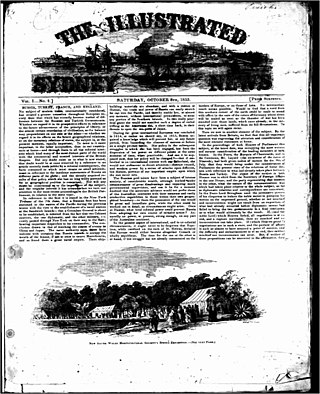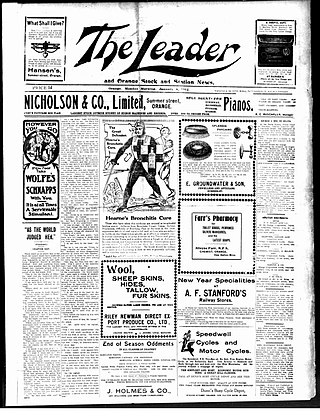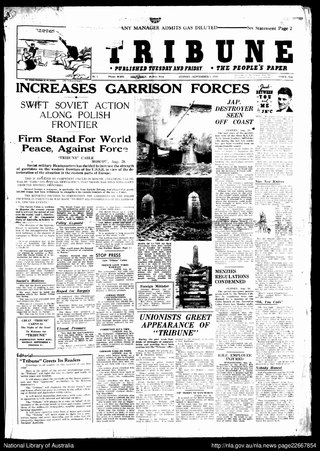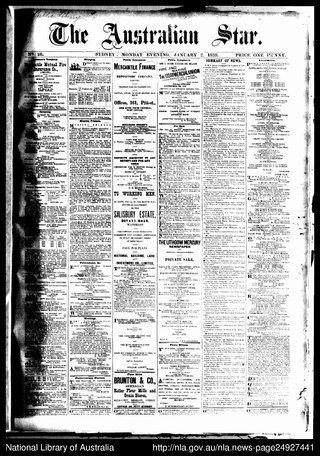
The Sydney Mail was an Australian magazine published weekly in Sydney. It was the weekly edition of The Sydney Morning Herald newspaper and ran from 1860 to 1938.

The Sun was an Australian afternoon tabloid newspaper, first published in Sydney under that name in 1910.
The Castlereagh, also published as The Gilgandra Weekly and Castlereagh and The Gilgandra Weekly, was the first newspaper published in Gilgandra, New South Wales, Australia. It was an English language paper, published weekly in broadsheet format.

The Illustrated Sydney News was a monthly English language newspaper published in Sydney, New South Wales, Australia.

The Arrow was a weekly English-language broadsheet newspaper published in Sydney, Australia between 1896 and 1933. The paper had previously been published under two earlier titles, The Dead Bird and Bird O’Freedom and also appeared as the Saturday Referee and the Arrow. It was later absorbed by The Referee.

The Barrier Miner was a daily broadsheet newspaper published in Broken Hill in far western New South Wales from 1888 to 1974.

The Evening News was the first evening newspaper published in Sydney, New South Wales, Australia. It was published from 29 July 1867 to 21 March 1931. The Sunday edition was published as the Sunday News.

The Southern Morning Herald was an English language newspaper published in Goulburn, New South Wales. It was first published in 1868 before the federation of Australia and later absorbed the Goulburn Herald, a contemporary competitor for many years.
The Land is an English language newspaper published in Sydney and later in North Richmond, New South Wales by Australian Community Media. The newspaper commenced publication in 1911.

The Catholic Weekly is an English language newspaper currently published in Sydney, Australia. It is published in tabloid format. Throughout its history, it has also been published as The Freeman's Journal and Catholic Freeman's Journal.

The Albury Banner and Wodonga Express was a weekly English language newspaper published in Albury, New South Wales, Australia.

The Leader was an English-language newspaper published in Orange, New South Wales from 1890 to 1945, being a successor to the Orange Liberal. It began briefly as The Orange Leader, then The Orange Leader and Millthorpe Messenger before the masthead became The Leader for more than forty years.

The Referee was a newspaper published in Sydney, Australia from 1886 to 1939.
John Louis Treflé was a farmer, newspaper proprietor and politician in New South Wales, Australia.

The Milton Ulladulla Times is an English language newspaper published in Ulladulla, New South Wales, Australia. It is printed and published by Paul Poulus for the Milton-Ulladulla Publishing Co. Pty. Ltd.

Charles White, was an Australian journalist, author and historian, notable for his books on bushranging and other aspects of Australian history.
Harry James Stephens was an Australian journalist with a long career, mostly in Victoria and New South Wales agricultural districts. He was with The Farmer & Settler of Sydney for fourteen years and while editing that paper created Australia's first Country Party; later was editor of rival newspaper The Land.

Tribune was the official newspaper of the Communist Party of Australia. It was published by the Central Committee of the Communist Party of Australia from 1939 to 1991. Initially it was subtitled as Tribune: The People's Paper. It was also published as the Qld Guardian, Guardian (Melbourne), Forward (Sydney). It had previously been published as The Australian Communist, (1920-1921) The Communist, (1921-1923) and the Workers' Weekly (1923-1939).

The Australian Star was a daily English-language newspaper published in Sydney, New South Wales, Australia, from 1887 to 1909. It was published as The Star, also known as The Star: the Australian Evening Daily, until 1910 and then renamed The Sun, which continued publication until 1988.
The Farmers' and Settlers' Association of New South Wales was an umbrella organisation of farmers' and selectors' associations in New South Wales, founded in 1893.
















